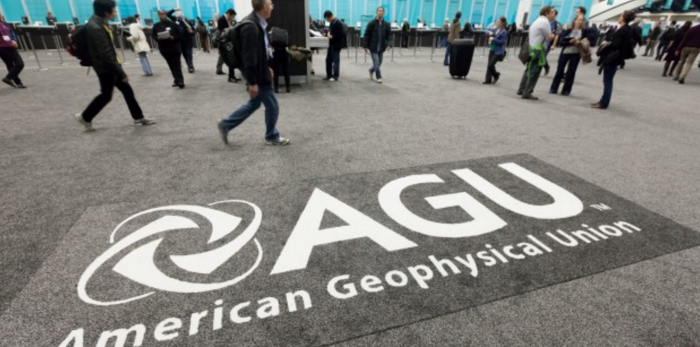Featured Stories, MIT, MIT EAPS, News | February 2, 2018
Outstanding at AGU 2017
Two from EAPS awarded for their 2017 AGU presentation.

By Helen Hill | EAPS News
Congratulations to graduate students Daniel Gilford and Clara Maurel who have been awarded an Outstanding Student Presentation Award (OSPA) for their presentations at the Fall Meeting of the American Geophysical Union held in New Orleans in December.
Clara Maural was awarded an Outstanding Student Presentation Award (OSPA) for her presentation Paleomagnetic Evidence for Partial Differentiation of the Silicate-Bearing IIE Iron Meteorite Parent Body. Maurel’s co-authors were her advisor, Benjamin Weiss and collaborators James Francis Joseph Bryson (University of Cambridge, UK) and Andreas Scholl (Lawrence Berkeley National Laboratory.)
“Meteorites are the fundamental tracers of the early history of the solar system. Most of them originated from ancient asteroids that built the planets by accreting and colliding with each other. Today we can study meteorites to understand what the ‘building blocks of the planets’ were made of,” says Maurel.
“In the Weiss Lab, my work focuses on the magnetic properties of iron meteorites (meteorites that are made of metal). Some iron meteorites have the capacity to durably record a magnetic field that their parent asteroid generated billion years ago (like the Earth does today)! We can use this record to investigate the structure of the first objects that grew up in the solar system.”
Maurel says the work she presented at AGU focuses on one particular family of meteorites that could change the way the structure of ancient asteroids has been seen until now. “Our magnetic measurements seem to run in favor of a greater structural diversity among the building blocks of the planets, which, from a broader perspective, for example, could have implications for the types of material and temperature in the proto-planetary disk, as well as the time it took for planets to form.”
Daniel Gilford was awarded an Outstanding Student Presentation Award (OSPA) for his presentation Analyzing nearly four decades of historical radiosonde observations of tropical tropopause layer and cold-point temperatures. His co-author was William John Randel (National Center for Atmospheric Research.)
Gilford says, “Last summer I was privileged to visit the National Center for Atmospheric Research for two months. At NCAR I began working with Dr. Bill Randel on a project to investigate tropical middle atmospheric temperature variability and trends as measured by radiosonde (balloon-borne) instruments over the past 40 years. Gilford’s talk at AGU summarized their findings.
The temperature of the tropical lower stratosphere acts as a gate, regulating the amount of water that reaches the stratosphere. The variability of stratospheric water vapor is a critical component in the climate system, as it can affect the earth’s radiative balance and either offset or contribute to climate change over decadal periods (e.g. it likely offset about 12% of anthropogenic CO2 forcing from 1990-2013). Furthermore, the speed limits (the maximum achievable intensity) of tropical cyclones (called hurricanes in the North Atlantic) are regulated in part by the temperatures of the tropical lower stratosphere. Understanding the short-term variability and trends of tropical lower stratospheric temperatures is therefore important for implications in the climate system and more specifically for the tropical cyclone intensities experienced by coastal societies.
The challenge, however, is that historical estimates of land-based measurements of tropical lower stratospheric temperatures have significant uncertainties. This is because “radiosondes”, instruments carried by balloons to measure the atmosphere, have changed recording practices (recording frequency, instrument types, locations, etc.) over the historical period, leading to either incomplete or discordant records. The goal of the project Gilford presented at AGU was to use satellite records (since 1979) to illuminate which radiosonde measurements are most trustworthy.
“By directly comparing radiosonde and satellite measurements we are able to iteratively narrow down our list of most “trustworthy” stations, and from there we estimate the long-term trends in lower stratospheric temperatures (since the beginning of the satellite era) and their year-to-year variability,” Says Gilford. “This work is a first step towards assembling a comprehensive dataset of radiosonde measurements that could be used for a wide-range of lower stratospheric applications, and our results have promising implications for stratospheric water vapor and tropical cyclone speed limits.”
You can read read more about lower stratospheric temperatures and their effects on tropical cyclones in Gilford’s thesis “The Tropopause Region Thermal Structure and Tropical Cyclones”, arriving online through the MIT library in spring 2018. Gilford is now a postdoc at Rutgers University.
The NCAR/AGU project and travel were funded by an NSF grant (PIs: Susan Solomon and Kerry Emanuel) and the Houghton Fund.
Other 2017 OSPA winners include incoming postdoc Claire Nichols.
Nichols, who joins the Weiss Group as a Simons Foundation Postdoctoral Fellow, received an OSPA for her presentation GP23B-0923: Magnetic and microstructural characterisation of FeNi: Insight into the formation and impact history of the IAB parent body.
Please note this story was updated from a January 31, 2018 post.





